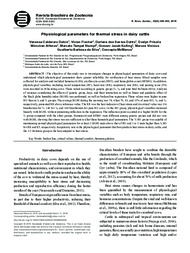Physiological parameters for thermal stress in dairy cattle.
Physiological parameters for thermal stress in dairy cattle.
Author(s): DALCIN, V. C.; FISCHER, V.; DALTRO, D. dos S.; ALFONZO, E. P. M.; STUMPF, M. T.; KOLLING, G. J.; SILVA, M. V. G. B.; McMANUS, C.
Summary: The objective of this study was to investigate changes in physiological parameters of dairy cows and understand which physiological parameters show greater reliability for verification of heat stress. Blood samples were collected for analysis and included hematocrit (Ht), erythrocyte count (ERY), and hemoglobin count (HEMO). In addition, physiological variables, including rectal temperature (RT), heart rate (HR), respiratory rate (RR), and panting score (PS) were recorded in 38 lactating cows. These varied according to genetic group (½, ¾, and pure bred Holstein (HO)). Analysis of variance considering the effects of genetic group, days, and their interaction as well as linear and quadratic effect of the black globe humidity index (BGHI) was performed, as well as broken-line regression. These values were higher in pure HO than in ¾ and ½ groups. The average BGHI during the morning was 74, when 70, 43, and 13% of pure HO, ¾, and ½, respectively, presented RR above reference value. The RR was the best indicator of heat stress and its critical value was 116 breaths/min for ½, 140 for ¾, and 168 breaths/min for pure HO cows. In the HO group, physiological variables increased linearly with BGHI, without presenting inflection in the regression. The inflection point occurred at a higher BGHI for the ½ group compared with the other groups. Hematocrit and HEMO were different among genetic groups and did not vary with BGHI, showing that stress was not sufficient to alter these hematological parameters. The ½ HO group was capable of maintaining normal physiological parameters for at least 3 BGHI units above that of HO and 1 to 3 units higher than ¾ HO for RR and RT, respectively. Respiratory rate is the physiological parameter that best predicts heat stress in dairy cattle, and the 1/2 Holstein group is the best adapted to heat stress.
Publication year: 2016
Types of publication: Journal article
Unit: Embrapa Dairy Cattle
Keywords: Animal comfort, Broken line, Critical values, Thermal comfort, thermoregulation
Observation
Some of Embrapa's publications are published as ePub files. To read them, use or download one of the following free software options to your computer or mobile device. Android: Google Play Books; IOS: iBooks; Windows and Linux: Calibre.
Access other publications
Access the Agricultural Research Database (BDPA) to consult Embrapa's full library collection and records.
Visit Embrapa Bookstore to purchase books and other publications sold by Embrapa.

